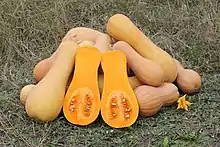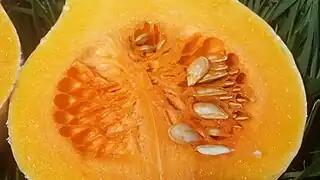Butternut squash
Butternut squash (Cucurbita moschata), known in Australia and New Zealand as butternut pumpkin or gramma,[1] is a type of winter squash that grows on a vine. It has a sweet, nutty taste similar to that of a pumpkin. It has tan-yellow skin and orange fleshy pulp with a compartment of seeds in the blossom end. When ripe, it turns increasingly deep orange, and becomes sweeter and richer. It is a good source of fiber, vitamin C, magnesium, and potassium; and it is a source of vitamin A.
| Cucurbita moschata 'Butternut' | |
|---|---|
 Ripe butternut squash | |
| Species | Cucurbita moschata |
| Hybrid parentage | 'Gooseneck squash' × 'Hubbard squash' |
| Breeder | Charles Leggett |
| Origin | 1940s in Stow, Massachusetts, United States |


Although botanically a fruit (specifically, a berry), butternut squash is used culinarily as a vegetable that can be roasted, sautéed, toasted, puréed for soups such as squash soup, or mashed to be used in casseroles, breads, muffins, and pies. It is part of the same squash family as ponca, waltham, pumpkin, and calabaza.[2]
| Nutritional value per 100 g (3.5 oz) | |
|---|---|
| Energy | 188 kJ (45 kcal) |
11.69 g | |
| Dietary fiber | 2 g |
0.1 g | |
1 g | |
| Vitamins | Quantity %DV† |
| Vitamin A equiv. | 67% 532 μg39% 4226 μg |
| Thiamine (B1) | 9% 0.1 mg |
| Riboflavin (B2) | 2% 0.02 mg |
| Niacin (B3) | 8% 1.2 mg |
| Pantothenic acid (B5) | 8% 0.4 mg |
| Vitamin B6 | 12% 0.154 mg |
| Folate (B9) | 7% 27 μg |
| Vitamin C | 25% 21 mg |
| Vitamin E | 10% 1.44 mg |
| Minerals | Quantity %DV† |
| Calcium | 5% 48 mg |
| Iron | 5% 0.7 mg |
| Magnesium | 10% 34 mg |
| Manganese | 10% 0.202 mg |
| Phosphorus | 5% 33 mg |
| Potassium | 7% 352 mg |
| Zinc | 2% 0.15 mg |
| Other constituents | Quantity |
| Water | 86.4 g |
| |
| †Percentages are roughly approximated using US recommendations for adults. Source: USDA FoodData Central | |
History
The word squash comes from the Narragansett word askutasquash, meaning "eaten raw or uncooked",[3][4] and butternut from the squash's nutty flavor. Although American native peoples may have eaten some forms of squash without cooking, today most squash is eaten cooked.[4] Native Americans believed that squash was so nutritious that they would bury their dead with it to sustain them on their final journey.[5]
Before the arrival of Europeans, C. moschata had been carried over all parts of North America where it could be grown,[4] but butternut squash is a modern variety of winter squash. It was developed by Charles Legget of Stow, Massachusetts, in 1944 who crossed pumpkin and gooseneck squash varieties.[6]
Attributes
Butternut squash will store for two to three months. Some varieties will keep up to six months. They are best kept at 10 °C (50 °F) with 50 percent humidity.[7] For the best flavor, butternut squash should be left to cure for 2 months after harvest.[8]
Nutrition

Raw butternut squash is 86% water, 12% carbohydrates, 1% protein, and contains negligible fat (table). A 100-gram reference amount supplies 188 kilojoules (45 kilocalories) of food energy, is a rich source (20% or more of the Daily Value, DV) of vitamin A (67% DV) and vitamin C (25% DV), and contains moderate amounts of vitamin B6, vitamin E, magnesium, and manganese, each having content of 10–12% DV.
Culinary uses
One of the most common ways to prepare butternut squash is roasting. Once roasted, it can be eaten in a variety of ways.[9] The fruit is prepared by removing the skin, stalk, and seeds, which are not usually eaten or cooked.[10] However, the seeds are edible, either raw or roasted, and the skin is also edible and softens when roasted. The seeds can even be roasted and pressed into an oil to create butternut squash seed oil. This oil can be used for roasting, cooking, on popcorn, or as a salad dressing.[11]
In Australia, it is regarded as a pumpkin, and is used interchangeably with other types of pumpkin.[12]
In South Africa, butternut squash is commonly used and often prepared as a soup or grilled whole. Grilled butternut is typically seasoned with nutmeg and cinnamon or stuffed (e.g., spinach and feta) before being wrapped in foil and grilled. Grilled butternut is often served as a side dish to braais (barbecues) and the soup as a starter dish.
Butternuts were introduced commercially in New Zealand in the 1950s by brothers Arthur and David Harrison, nursery workers, and Otaki market gardeners.
See also
References
- "Commercial production of pumpkins and grammas". Department of Agriculture and Fisheries. Archived from the original on 6 August 2016. Retrieved 29 June 2016.
- GourmetSleuth. "Butternut Squash". Gourmet Sleuth. Retrieved 29 March 2020.
- "How Did the Squash Get its Name?". Library of Congress. Retrieved 15 July 2022.
- Victor E. Boswell and Else Bostelmann. "Our Vegetable Travelers." The National Geographic Magazine. 96.2: August 1949.
- "The History of Butternut Squash". Our Everyday Life. Retrieved 29 March 2020.
- Spitza, Ashleigh; Sentinel, Milwaukee Journal (8 November 2017). "Butternut squash a brilliant choice for color and nutrition". Milwaukee Journal Sentinel. Retrieved 12 March 2022.
- Munro, Derek B.; Small, Ernest (1997). Vegetables of Canada. NRC Research Press. p. 179. ISBN 9780660195032. Retrieved 2 February 2020.
- "Curing & Storage Chart for Winter Squash | Johnny's Selected Seeds". johnnyseeds.com. Retrieved 18 September 2020.
- "Butternut Squash". Traditional-Foods.com. 2011. Archived from the original on 7 January 2012. Retrieved 7 January 2012.
{{cite web}}: CS1 maint: bot: original URL status unknown (link) - "Butternut Squash". Veg Box Recipes. 2008. Archived from the original on 28 September 2013. Retrieved 15 September 2013.
- Bilow, Rochelle. "Butternut Squash Seed Oil Is Exactly What Your Pantry Has Been Missing". Bon Appétit. Retrieved 15 June 2020.
- "The strange history of the butternut". Farmer's Weekly. 21 September 2013. Retrieved 29 March 2020.
